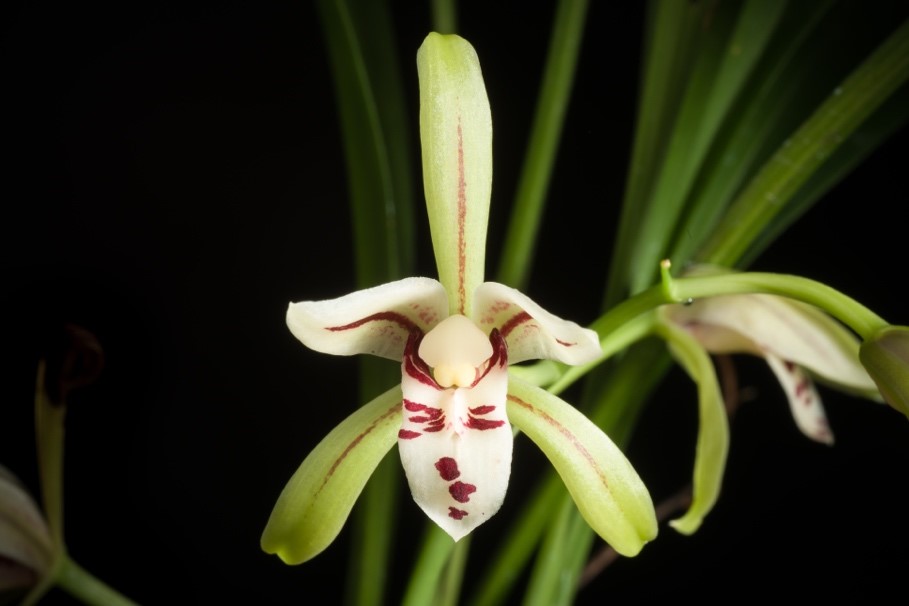Description

Disclaimer: Copyright infringement not intended.
Context
- Cymbidium lancifolium is an extremely rare and terrestrial orchid species recently discovered in the Chopta valley of Uttarakhand's Western Himalayan region.
Details
- The discovery of this species was made by the research wing staff of Uttarakhand's forest department during a 'plant exploration survey' in and around the Chopta Valley.
- Prior to this discovery, Cymbidium lancifolium was only reported in north-eastern regions of India and Bhutan.
Characteristics and Significance
- Cymbidium orchids are highly popular and cultivated on a large scale worldwide due to their long-lasting property, wide range of colors, and elegant appearance.
- The discovery of Cymbidium lancifolium in Chopta valley highlights the importance of conservation efforts to protect rare and beautiful species.
Research Wing's Achievements
- The research wing of Uttarakhand's forest department has made several significant discoveries of floral species in the Western Himalayas in recent years.
- In 2020, they found Liparis pygmaea during the Saptkund trek, which was reported in India after 124 years and published in the prestigious French journal 'Richardiana.'
- Cephalanthera erecta var. oblanceolata was recorded from the Mandal valley of Chamoli district in 2021, marking a new record for the flora of India, and the finding was published in 'Nelumbo.'
- Another rare carnivorous plant, Utricularia furcellata, was documented from the Western Himalayas in 2022, and the finding was published in the prestigious 'Journal of Japanese Botany.'
Chopta Valley
- Chopta valley is situated in the Western Himalayas of Uttarakhand, India, at an elevation of approximately 1761 meters (5778 feet) above sea level.
- The valley is renowned for its breathtaking landscapes, rich biodiversity, and pristine natural beauty, making it a popular destination for nature enthusiasts, trekkers, and wildlife lovers.
- Chopta is often referred to as the "Mini Switzerland" of India due to its picturesque meadows, snow-capped peaks, and dense forests.
- The valley is surrounded by the majestic peaks of the Himalayan range, including Chaukhamba, Kedarnath, and Trishul, adding to its scenic splendor.
- It serves as the base for various trekking routes, including the famous Tungnath and Chandrashila treks, attracting adventurers and pilgrims alike.
- Chopta valley is a part of the Kedarnath Wildlife Sanctuary, and its diverse habitats support a wide range of flora and fauna, including rare and endangered species like Cymbidium lancifolium.
- The region's unique ecological characteristics, combined with its cultural and natural significance, make Chopta valley a vital area for conservation and sustainable tourism practices.

Orchids: Exquisite and Diverse Flowering Plants
- Orchids, scientifically known as Orchidaceae, are a diverse and fascinating family of flowering plants.
- They belong to the order Asparagales and are renowned for their exquisite and often flamboyant flowers.
- Orchids are found all over the world, from tropical rainforests to arctic tundra, and they display incredible adaptability to various habitats.
Rich Diversity
- Orchids are one of the largest plant families, with approximately 25,000 to 30,000 known species and countless hybrids and varieties.
- They come in an array of shapes, sizes, and colors, showcasing some of the most striking and intricate floral designs in the plant kingdom.
Unique Floral Structure
- The unique floral structure of orchids sets them apart from other flowering plants.
- Orchid flowers have three sepals and three petals, but one petal is highly modified and termed the "lip" or "labellum."
- This labellum often serves as a landing platform for pollinators and can have various attractive markings, patterns, and colors.
Pollination Strategies
- Orchids have evolved diverse pollination strategies to attract specific pollinators, such as insects, birds, or even mammals.
- Some orchids produce nectar to lure pollinators, while others use deception, mimicry, or fragrance to entice them.
- Some orchids have evolved striking visual resemblances to female insects, tricking male insects into attempting to mate with the flower and inadvertently transferring pollen.
Epiphytic Lifestyle
- Many orchid species are epiphytes, meaning they grow on the surface of other plants, such as trees.
- They do not harm the host plant but use it as a support structure to access sunlight and nutrients.
- Epiphytic orchids have specialized aerial roots that aid in water and nutrient absorption.
Mycorrhizal Relationship
- Orchids often form symbiotic relationships with mycorrhizal fungi in their roots.
- The fungi assist the orchids in nutrient uptake, especially in nutrient-poor environments. In return, the orchids provide the fungi with sugars produced through photosynthesis.
Economic Importance
- Apart from their ornamental value, orchids hold economic significance as well.
- Some orchid species are used in traditional medicine and herbal remedies.
- Additionally, the fragrance industry extracts essential oils from certain orchids to create perfumes and scents.
Conservation Concerns
- Despite their beauty and popularity, many orchid species are threatened by habitat loss, over-collection, and illegal trade.
- Several orchid species are listed as endangered or critically endangered, warranting conservation efforts to protect them and their natural habitats.
Orchid Cultivation
- Orchids have long captivated horticulturists and plant enthusiasts.
- Their unique beauty and wide range of forms have made them popular subjects for cultivation.
- However, growing orchids can be challenging due to their specific requirements for light, temperature, humidity, and proper care.
Symbolism and Culture
- Orchids hold cultural and symbolic significance in various societies.
- In some cultures, they represent love, beauty, and fertility, while in others, they are seen as a symbol of luxury and refinement.

Conclusion
The discovery of Cymbidium lancifolium in the Chopta valley is a significant contribution to the understanding of the rich biodiversity of Uttarakhand's Western Himalayan region. It highlights the need for continued efforts to explore and conserve the diverse flora and fauna of this ecologically important area.
|
PRACTICE QUESTION
Which of the following statements about Cymbidium lancifolium is correct?
1.Cymbidium lancifolium is an aquatic weed native to Central and South America.
2.The discovery of Cymbidium lancifolium was made in the Western Himalayan region of Uttarakhand, particularly in the Chopta valley.
3.Cymbidium lancifolium is primarily known for its tiny yellow flowers and is commonly cultivated for ornamental purposes.
a. Only statements 1 and 2 are correct.
b. Only statements 2 and 3 are correct.
c. Only statements 1 and 3 are correct.
d. All of the above statements are correct.
Answer: b
|
https://timesofindia.indiatimes.com/city/dehradun/rare-orchid-species-found-in-ukhands-chopta-valley/articleshow/102001535.cms?from=mdr
















